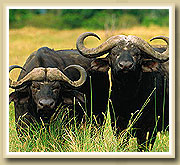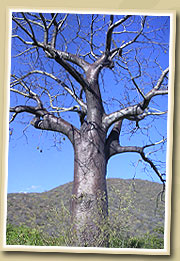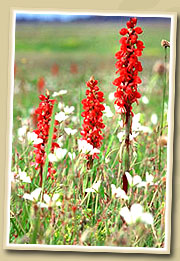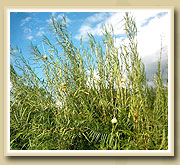Tanzania
Southern Parks
Mikumi National
Park
Tanzania 's third largest National Park, covering
3230 square kilometres, Mikumi is one of the most popular
of Tanzania 's National Parks. One of the principal features
of Mikumi is the Mkata River Flood plain (an area of lush
vegetation which attracts large numbers of elephants and
buffaloes) along with the mountain ranges that border the
park on two sides (in the east the Uluguru Mountains , in
the west the Rubeho Mountains ). Open grasslands dominate
the flood plain, eventually merging with the miombo woodland
covering the lower hills.
Back To Top
Selous Game
Reserve
Named after legendary British explorer, Frederick Courtenay
Selous, the Reserve (more than three times the size of Serengeti
National Park and twice the size of Belgium ), was founded
in 1905 by the colonial administration and later expanded
to include the traditional elephant migration routes. The
Reserve is uninhabited and little touched by human interference.
Visitors therefore will find themselves in a pristine wilderness
far away from the established tourist routes. Its wildlife
(including some of the last remaining black rhinoes) is
spectacular, and some mammal populations (buffaloes, elephants,
hippos, wild dogs, crocodiles) are the largest in Africa.
Back To Top
Udzungwa
National Park
Covers 1,990 square kilometres and is particularly suitable
for hiking and climbing with trails through the rainforest
and on the escarpment. The plateau is a natural lookout
with views of sugar plantations against a patchwork of
grassland and mountain forest extending over 100 kilometres.
The centrepiece is the Sanje River which reinvents itself
as a spectacular waterfall, plunging 170 meters through
the forest to land in a spray of mist in the valley below.
Two types of monkeys, the Iringa red colobus monkey and
the Sanje Crested Mangabey, are endemic to the Udzungwa
Mountains and are no found elsewhere in the mountains
of Eastern Tanzania . Furthermore Udzungwa is particularly
alluring to birdwatchers.
Back To Top
Ruaha National
Park
Ruaha, the second largest (after the Serengeti) of Tanzania
National Parks, with its dramatic geography, is truly
a vast unspoiled wilderness covering some 13,000 square
kilometres and is amongst the wildest in Africa . It is
part of an enormous expanse of protected land - the 30,000
square kilometre Rungwa - Kisigo - Ruaha ecosystem, most
of which made up the Saba Game Reserve in former German
colonial times. Ruaha is also interesting as it represents
a transition zone where eastern and southern African species
of fauna and flora overlap.
The river, after which the Park is named,
winds through the eastern section, fringed by tall trees:
acacia albida, tamarind and wild figs, as well as the
majestic baobab, which could be regarded as the signature
tree of Ruaha.
The valley of the Great Ruaha River is
thought to be an extension of the Great Rift Valley and
the Ruaha flows along the Park's entire eastern boundary
through rugged gorges and open plains.
A rich diversity of animal and plant life is sheltered
by the Park. Ruaha is a hauntingly beautiful and wild
landscape of miombo forest, rolling woodlands, hills,
rivers and plains and possesses a great variety of wildlife,
including lion, leopard, cheetah, hunting dog, warthog,
giraffe, zebra, huge herds of buffalo and large concentrations
of elephant. It is the only East African Part where it
is possible to see the greater and lesser kudu, as well
as sable and roan antelopes.
Back To Top
Kitulo
National Park - Locals refer
to the Kitulo Plateau as Bustani ya Mungu - The
Garden of God - while botanists have dubbed it the Serengeti
of Flowers, host to 'one of the great floral spectacles
of the world'. And Kitulo is indeed a rare botanical marvel,
home to a full 350 species of vascular plants, including
45 varieties of terrestrial orchid, which erupt into a
riotous wildflower display of breathtaking scale and diversity
during the main rainy season of late November to April.
Perched at around
2,600 metres (8,500 ft) between the rugged peaks of the
Kipengere, Poroto and Livingstone Mountains, the well-watered
volcanic soils of Kitulo support the largest and most important
montane grassland community in Tanzania.
One of the most important
watersheds for the Great Ruaha River, Kitulo is well known
for its floral significance - not only a multitude of orchids,
but also the stunning yellow-orange red-hot poker and a
variety of aloes, proteas, geraniums, giant lobelias, lilies
and aster daisies, of which more than 30 species are endemic
to southern Tanzania.
Big game is sparsely represented, though a few hardy mountain
reedbuck and eland still roam the open grassland.
But Kitulo - a botanist and hiker's paradise - is also highly
alluring to birdwatchers. Tanzania's only population of
the rare Denham's bustard is resident, alongside a breeding
colony of the endangered blue swallow and such range-restricted
species as mountain marsh widow, Njombe cisticola and Kipengere
seedeater. Endemic species of butterfly, chameleon, lizard
and frog further enhance the biological wealth of God's
Garden.
About Kitulo
Plateau National Park
Size: 412.9 sq km (159 sq miles)
Location: Southern Tanzania.
The temporary park headquarters at Matamba are situated
approximately 100km (60 miles) from Mbeya town.




